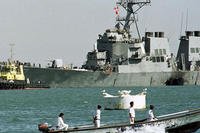It's no secret that Navy leaders want to build a fleet much bigger than the current 274 ships to sustain operations around the globe.
But maintenance backlogs and deferments that sideline operations ships and keep sailors from deploying are creating a crisis of their own, Vice Chief of Naval Operations Bill Moran said.
Speaking at the Surface Navy Association's annual symposium near Washington, D.C., on Tuesday, Moran said Navy leaders have already told President-elect Donald Trump's transition team that they want any additional funding that comes available within this fiscal year to go to maintenance first.
"The transition team came around to all of us in the building and asked us what we could do with more money right now," Moran said. "The answer was not, 'Buy more ships.' The answer was, 'Make sure that the 274 that we had were maintained and modernized to provide 274 ships' worth of combat time.' Then, we'll start buying more ships."
Moran said he supported the Navy's new force structure assessment calling for a fleet of 355 ships to meet current operational demands, and added that three separate internal reviews had all arrived at similar numbers. But he also said maintenance backlogs and deferred availabilities are costing the Navy tens of millions of dollars and leaving risky gaps at sea.
In two recent examples, he said, the dock landing ship Carter Hall had seen its maintenance availability nearly double from a planned 344 days to 678, with a cost increase of more than $50 million, and the destroyer Russell had its maintenance cycle bloat from 92 days to 459 and counting, with costs multiplying from a planned $8 million to $89 million.
"Both Carter Hall and Russell lost a full year of operational availability," Moran said. "So it's really hard to see the light at the end of this tunnel. Fewer steaming hours and training, deployment hours, deferred maintenance … it all takes time from the young sailors to learn a new system, increase their proficiency at sea and qualify. As I said, you can't buy that back. At some point, you just have to dig in and dig out of this problem."
In addition to asking for funding to replenish maintenance accounts and clear backlogs, Moran said it was crucial that the Navy reduce its operational tempo and limit the length of deployments, which have been frequently extended at sea in recent years, in order to keep to planned maintenance and reset schedules. To that end, Moran said, the service has been setting limits on deployments, even when it means accepting operational risk.
The departure of the carrier Dwight D. Eisenhower from the Middle East at the end of the year left a rare gap in the region, as the carrier George H. W. Bush continued its pre-deployment training workup following an extended maintenance cycle.
"The gaps we've seen, that we've accepted in taking risk and the operational risk that we've taken are related to the fact that if we keep on extending deployments and turning people around faster than their schedule, that we'll never dig out of that maintenance backlog," Moran said. "So we're purposefully taking risk to find the time to make sure that we don't get deployments extended beyond seven months, we get those ships back, we get them in maintenance and we commit to the funding."
The Bush is expected to deploy early this year.
-- Hope Hodge Seck can be reached at hope.seck@military.com. Follow her on Twitter at @HopeSeck.










